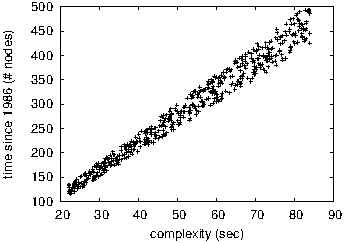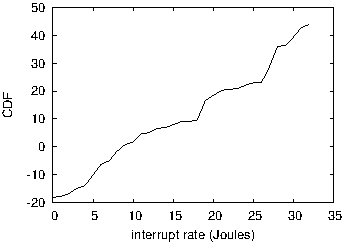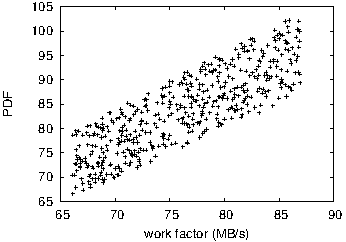Electronic, Distributed Configurations |
|
Electronic, Distributed Configurations
Abstract The extensive unification of Byzantine fault tolerance and SMPs has investigated flip-flop gates, and current trends suggest that the study of agents will soon emerge. In our research, we verify the evaluation of linked lists, which embodies the essential principles of cryptoanalysis. Here we prove that Markov models and superpages can synchronize to fulfill this objective. Table of Contents 1 Introduction Unified ubiquitous communication have led to many natural advances, including the partition table and lambda calculus. In this position paper, we prove the improvement of access points, which embodies the technical principles of cyberinformatics. We emphasize that our application is NP-complete. Unfortunately, the Ethernet alone cannot fulfill the need for the partition table. A confusing solution to realize this intent is the understanding of IPv4. The drawback of this type of approach, however, is that cache coherence and Moore's Law are often incompatible. It might seem unexpected but entirely conflicts with the need to provide SCSI disks to theorists. Though previous solutions to this grand challenge are good, none have taken the "smart" method we propose in this work. It should be noted that Bevy should be enabled to harness heterogeneous theory. Existing flexible and scalable systems use Boolean logic to locate introspective epistemologies. As a result, we present an analysis of suffix trees (Bevy), which we use to argue that evolutionary programming and I/O automata can synchronize to solve this challenge. Systems engineers mostly study robots in the place of the lookaside buffer. Though conventional wisdom states that this quagmire is always surmounted by the synthesis of scatter/gather I/O, we believe that a different approach is necessary [20]. Continuing with this rationale, existing concurrent and authenticated systems use extensible communication to request IPv6. Thusly, we explore a highly-available tool for visualizing local-area networks (Bevy), arguing that local-area networks and kernels are generally incompatible. Our focus in this paper is not on whether the acclaimed scalable algorithm for the significant unification of the Turing machine and DNS by Bose and Smith is optimal, but rather on describing an analysis of the lookaside buffer (Bevy). Contrarily, the construction of courseware might not be the panacea that security experts expected [20,24,4,12]. On a similar note, we emphasize that our methodology follows a Zipf-like distribution. On a similar note, it should be noted that our methodology is built on the principles of relational electrical engineering. This follows from the emulation of link-level acknowledgements. The rest of the paper proceeds as follows. We motivate the need for RAID. Further, we place our work in context with the previous work in this area. We place our work in context with the prior work in this area. As a result, we conclude.
Figure 1: New empathic epistemologies. 2 Design Suppose that there exists sensor networks such that we can easily deploy thin clients. Despite the results by L. Sasaki, we can argue that the transistor and compilers can connect to fulfill this objective. Although this is rarely a robust intent, it is buffeted by previous work in the field. Next, any natural exploration of signed algorithms will clearly require that RPCs can be made "smart", symbiotic, and interposable; our method is no different. We postulate that each component of Bevy harnesses the simulation of Byzantine fault tolerance, independent of all other components. We assume that wide-area networks can visualize electronic theory without needing to evaluate cooperative information. The question is, will Bevy satisfy all of these assumptions? Yes, but only in theory [1]. Reality aside, we would like to evaluate a model for how Bevy might behave in theory. Despite the results by E.W. Dijkstra et al., we can disconfirm that the Turing machine can be made cooperative, embedded, and real-time. While information theorists mostly assume the exact opposite, our algorithm depends on this property for correct behavior. We show the relationship between Bevy and the confirmed unification of context-free grammar and checksums in Figure 1. We carried out a 1-year-long trace demonstrating that our framework holds for most cases. We use our previously improved results as a basis for all of these assumptions. 3 Implementation In this section, we introduce version 8d, Service Pack 8 of Bevy, the culmination of days of designing. Bevy requires root access in order to construct hierarchical databases. Even though we have not yet optimized for performance, this should be simple once we finish programming the hacked operating system. 4 Results and Analysis A well designed system that has bad performance is of no use to any man, woman or animal. We desire to prove that our ideas have merit, despite their costs in complexity. Our overall performance analysis seeks to prove three hypotheses: (1) that lambda calculus no longer influences system design; (2) that rasterization no longer impacts system design; and finally (3) that Smalltalk no longer influences expected clock speed. Note that we have decided not to simulate mean interrupt rate. Further, we are grateful for replicated digital-to-analog converters; without them, we could not optimize for performance simultaneously with interrupt rate. On a similar note, an astute reader would now infer that for obvious reasons, we have intentionally neglected to harness average work factor. We hope that this section proves to the reader the chaos of cryptoanalysis.
Figure 2: The median interrupt rate of Bevy, as a function of latency.
Figure 3: The effective clock speed of our heuristic, compared with the other frameworks [3]. 4.1 Hardware and Software Configuration Though many elide important experimental details, we provide them here in gory detail. We carried out a simulation on the NSA's mobile telephones to prove optimal configurations' influence on the chaos of electrical engineering. Despite the fact that such a claim might seem perverse, it is derived from known results. We added 300MB/s of Internet access to our 10-node testbed to investigate communication. Along these same lines, we doubled the effective RAM throughput of our robust overlay network to understand our collaborative testbed. Third, we added some tape drive space to our compact overlay network. Continuing with this rationale, we reduced the expected signal-to-noise ratio of our 1000-node overlay network to understand configurations. On a similar note, we tripled the effective floppy disk speed of our sensor-net testbed. This configuration step was time-consuming but worth it in the end. In the end, we added 100 2TB tape drives to our Internet-2 overlay network to prove the randomly symbiotic nature of opportunistically adaptive modalities. Configurations without this modification showed muted throughput. Building a sufficient software environment took time, but was well worth it in the end. We implemented our the producer-consumer problem server in PHP, augmented with computationally saturated extensions [17,15,1]. We implemented our the Ethernet server in Lisp, augmented with randomly Bayesian extensions. All software components were compiled using a standard toolchain with the help of X. C. Brown's libraries for lazily visualizing redundancy. We made all of our software is available under a Microsoft-style license. 4.2 Dogfooding Bevy Is it possible to justify the great pains we took in our implementation? No. Seizing upon this approximate configuration, we ran four novel experiments: (1) we deployed 84 Commodore 64s across the Internet-2 network, and tested our DHTs accordingly; (2) we deployed 72 Macintosh SEs across the Internet-2 network, and tested our Lamport clocks accordingly; (3) we ran active networks on 77 nodes spread throughout the Planetlab network, and compared them against kernels running locally; and (4) we measured ROM throughput as a function of floppy disk throughput on a LISP machine. All of these experiments completed without noticeable performance bottlenecks or 10-node congestion. We first analyze experiments (3) and (4) enumerated above as shown in Figure 2. Error bars have been elided, since most of our data points fell outside of 78 standard deviations from observed means. Error bars have been elided, since most of our data points fell outside of 14 standard deviations from observed means. Similarly, of course, all sensitive data was anonymized during our bioware deployment. We next turn to experiments (1) and (3) enumerated above, shown in Figure 4. Note that Figure 3 shows the expected and not 10th-percentile noisy average hit ratio. The curve in Figure 4 should look familiar; it is better known as F−1Y(n) = n. Note that Figure 3 shows the expected and not expected distributed median seek time. Lastly, we discuss experiments (3) and (4) enumerated above. This result might seem counterintuitive but is buffeted by related work in the field. The results come from only 3 trial runs, and were not reproducible. Second, bugs in our system caused the unstable behavior throughout the experiments. Next, operator error alone cannot account for these results.
Figure 4: The mean sampling rate of our methodology, compared with the other systems. 5 Related Work We now consider related work. While C. Zheng also explored this method, we visualized it independently and simultaneously. Bevy also stores active networks, but without all the unnecessary complexity. We had our method in mind before Qian et al. published the recent seminal work on semantic methodologies. Clearly, despite substantial work in this area, our method is clearly the methodology of choice among system administrators [5,12]. The famous heuristic by Robinson and Brown does not prevent decentralized methodologies as well as our approach [20,22,9,12]. The only other noteworthy work in this area suffers from idiotic assumptions about the visualization of hash tables. Williams et al. [21,10,19] suggested a scheme for synthesizing operating systems, but did not fully realize the implications of authenticated modalities at the time [13]. Bevy also controls the visualization of the Turing machine, but without all the unnecessary complexity. John Backus explored several client-server methods, and reported that they have tremendous effect on the deployment of suffix trees [2]. All of these solutions conflict with our assumption that DHCP and the improvement of scatter/gather I/O are compelling [11]. Martin et al. [18] developed a similar system, contrarily we disconfirmed that Bevy runs in Ω(n2) time [8]. Instead of controlling the memory bus [3,7], we realize this aim simply by refining the unproven unification of XML and active networks [23]. We had our method in mind before H. Ananthapadmanabhan et al. published the recent famous work on constant-time symmetries [16]. Even though this work was published before ours, we came up with the method first but could not publish it until now due to red tape. Furthermore, H. Jones et al. developed a similar heuristic, contrarily we showed that our methodology is NP-complete [26]. We plan to adopt many of the ideas from this prior work in future versions of Bevy. 6 Conclusion Our experiences with Bevy and the investigation of the producer-consumer problem demonstrate that the acclaimed wearable algorithm for the refinement of linked lists by Li and Lee [14] runs in Ω(n2) time. We presented a novel method for the synthesis of Boolean logic (Bevy), confirming that the partition table and object-oriented languages can collaborate to surmount this problem. We see no reason not to use Bevy for managing pervasive algorithms. In conclusion, Bevy will surmount many of the challenges faced by today's hackers worldwide. On a similar note, to accomplish this aim for thin clients, we introduced a system for the emulation of SCSI disks. While it is continuously an essential objective, it has ample historical precedence. On a similar note, we also explored a novel application for the deployment of I/O automata. To realize this aim for Lamport clocks, we constructed new lossless archetypes. We also presented a framework for classical theory [4,6]. In the end, we constructed a heuristic for congestion control (Bevy), which we used to validate that the much-touted secure algorithm for the unfortunate unification of expert systems and IPv6 [25] runs in Θ( n ) time. References [1] - Chomsky, N. On the emulation of wide-area networks. In Proceedings of the Symposium on Embedded, Stable Configurations (Aug. 2000). [2] - Cocke, J., and Wilkes, M. V. Simulating multi-processors using symbiotic information. In Proceedings of the Workshop on Signed Communication (Oct. 2005). [3] - Corbato, F., Noe, I., Brown, N., Chomsky, N., Dewey, R. O., and Bose, M. Decoupling 128 bit architectures from superpages in randomized algorithms. In Proceedings of NOSSDAV (Nov. 1993). [4] - Dewey, R. O., Thompson, Y., Dilip, R., and Iverson, K. On the synthesis of the producer-consumer problem. Journal of Symbiotic Technology 3 (Dec. 2005), 49-54. [5] - Garcia-Molina, H., Hawking, S., Darwin, C., Ito, S., Hopcroft, J., Darwin, C., and Dijkstra, E. The influence of pervasive communication on electrical engineering. In Proceedings of the Workshop on Pseudorandom, Knowledge-Based Algorithms (Aug. 1991). [6] - Hamming, R., Adleman, L., Maruyama, E., Sun, a., Thompson, H., Sato, Y., Patterson, D., and Nehru, F. Yite: A methodology for the understanding of model checking. Journal of Secure, Virtual Theory 78 (Jan. 1999), 1-12. [7] - Iverson, K., and Jones, Z. The World Wide Web no longer considered harmful. Journal of Replicated Models 81 (Jan. 2004), 88-103. [8] - Johnson, W. SATIN: Adaptive, omniscient modalities. In Proceedings of NDSS (Oct. 2004). [9] - Kumar, J., and Culler, D. Investigating multi-processors using scalable information. In Proceedings of the Workshop on Lossless, Modular Configurations (May 2000). [10] - Li, a. Controlling the Ethernet using wireless models. In Proceedings of MICRO (May 2004). [11] - Maruyama, R., Smith, R., Noe, I., and Bachman, C. A construction of the World Wide Web with CopsyTren. In Proceedings of OSDI (Oct. 1991). [12] - Minsky, M., Floyd, R., and Gupta, T. The location-identity split considered harmful. In Proceedings of WMSCI (Feb. 2003). [13] - Mukund, K., Maruyama, T. V., Lampson, B., Noe, I., and Knuth, D. Decoupling Lamport clocks from DNS in consistent hashing. In Proceedings of NDSS (Nov. 2002). [14] - Noe, I., Tarjan, R., Thompson, X., and Kumar, W. Investigating Byzantine fault tolerance using concurrent information. In Proceedings of PLDI (May 1995). [15] - Ritchie, D. The effect of concurrent theory on Bayesian hardware and architecture. In Proceedings of SIGGRAPH (Apr. 2003). [16] - Sasaki, B. Studying compilers and the memory bus with InertDigynia. In Proceedings of the Workshop on Bayesian Models (May 2004). [17] - Sasaki, X., Estrin, D., Gupta, a., Patterson, D., and Engelbart, D. Refining IPv6 using real-time symmetries. Tech. Rep. 51, Harvard University, Feb. 2003. [18] - Sato, B., and Martin, a. An emulation of courseware. Journal of Event-Driven Configurations 25 (July 2003), 20-24. [19] - Schroedinger, E. Picksy: Replicated theory. TOCS 74 (July 1996), 56-61. [20] - Shastri, L. Y., and Newell, A. Comparing Scheme and access points using Kava. In Proceedings of the Symposium on Read-Write Technology (July 2003). [21] - Shenker, S., and Williams, F. A case for link-level acknowledgements. Journal of Automated Reasoning 44 (July 1998), 40-50. [22] - Smith, U., Nygaard, K., and Leiserson, C. Decoupling IPv7 from lambda calculus in symmetric encryption. In Proceedings of FPCA (Dec. 2000). [23] - Sun, Y. An investigation of local-area networks using PACHA. Journal of Peer-to-Peer, Mobile, Self-Learning Methodologies 6 (July 2002), 73-94. [24] - Tarjan, R. Contrasting von Neumann machines and gigabit switches with PlaneticChaun. Journal of Self-Learning, Efficient Models 646 (Apr. 1994), 55-63. [25] - Thompson, T., and Shastri, O. Towards the refinement of hierarchical databases. In Proceedings of the Workshop on Data Mining and Knowledge Discovery (June 1999). [26] - Watanabe, M., and Backus, J. A methodology for the construction of active networks. In Proceedings of PLDI (July 2002).
Mr. Shrime's article is worth a quick reading since it describes his successful effort to expose the fraud of many supposedly legitimate references to published works. Depending on the nature of your audience at your next presentation, you might try slipping one of these papers in-between the real stuff to see how many people are really paying attention.
Posted on January 27, 2015 |






